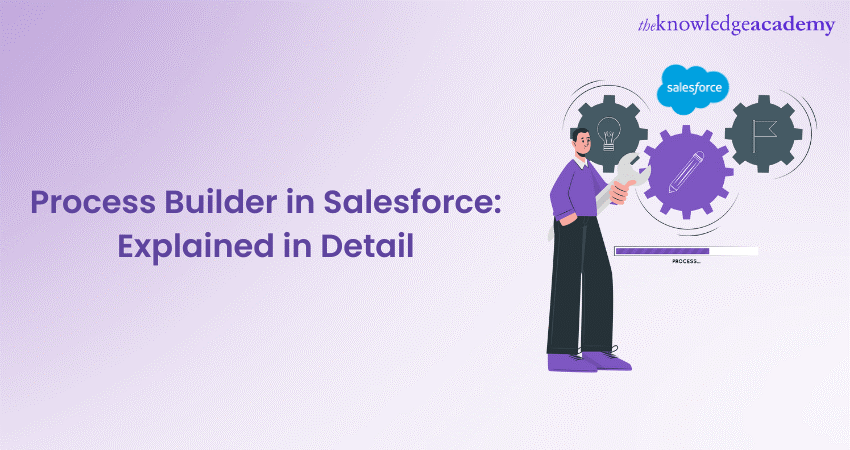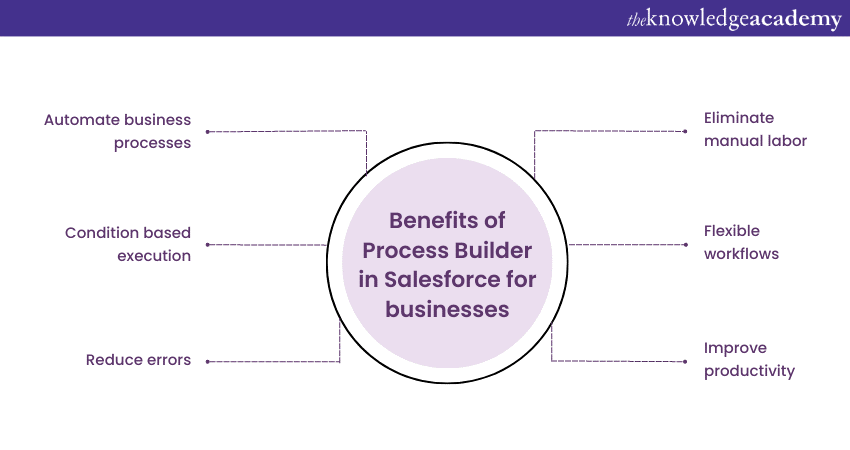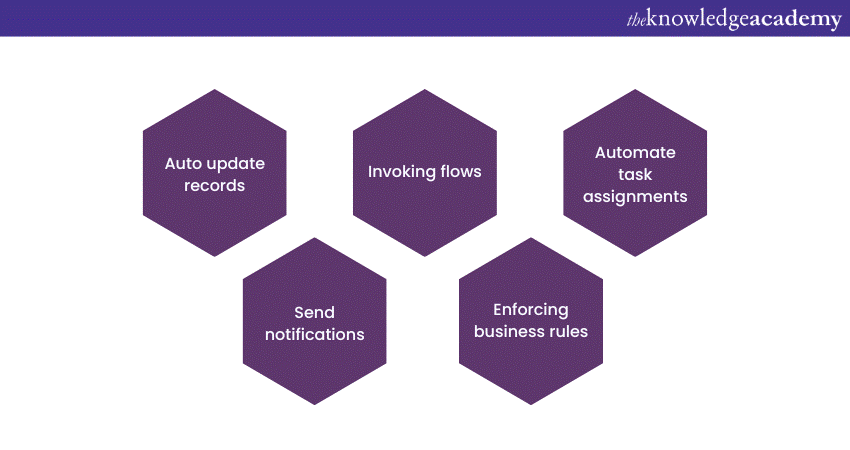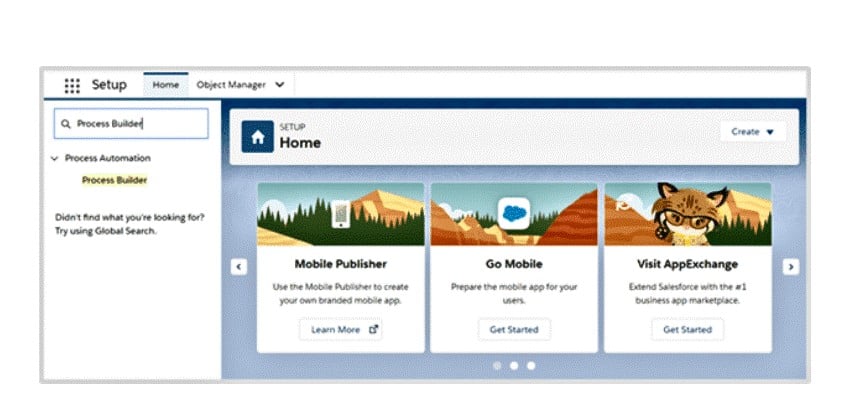We may not have the course you’re looking for. If you enquire or give us a call on + 1-866 272 8822 and speak to our training experts, we may still be able to help with your training requirements.
We ensure quality, budget-alignment, and timely delivery by our expert instructors.

In today's fast-paced business environment, organisations constantly seek ways to optimise their operations and increase efficiency. With its user-friendly interface and powerful capabilities, Process Builder in Salesforce empowers users to automate tasks, define criteria, and execute actions based on specific conditions.
It is a valuable automated tool designed to streamline and manage business systems within the Salesforce platform. In this blog, you will learn what a Process Builder in Salesforce is, how it helps businesses, its key features, and how to create one.
Table of Contents
1) What is a Process Builder in Salesforce?
2) How Process Builder in Salesforce helps businesses?
3) Key features of Process Builder
4) How to create a new process with Process Builder?
5) Common use cases for Process Builder
6) Conclusion
What is a Process Builder in Salesforce?
Process Builder is a powerful automation tool within Salesforce that allows users to streamline and optimise their business operations. It provides users with a visual interface for creating and managing automated workflows without the need for complex coding. Here are some key points to understand about Process Builder:
a) It offers a visual interface, making it accessible to users without coding knowledge.
b) Specific events or conditions in Salesforce trigger actions in Process Builder.
c) Users can define criteria and actions executed when the specified conditions are met.
d) It enables users to update fields, create records, and send emails.
e) Process Builder serves as a bridge between different Salesforce features, facilitating integration and automation.
f) The visual representation of processes simplifies design, troubleshooting, and maintenance.
g) It helps reduce manual effort, enhance productivity, and ensure consistent processes within Salesforce.

How Process Builder in Salesforce helps businesses?
Salesforce Process Builder serves a specific purpose in automating and managing business processes. Here's how it can help businesses:

a) The main purpose of Process Builder is to streamline and automate business operations within Salesforce.
b) It allows users to define criteria and actions to execute when specific conditions are met.
c) With Process Builder, you can create a series of actions, known as a process, to be executed when a record meets the specified criteria.
d) By automating functions with the Process Builder, you can eliminate manual tasks, reduce errors, and improve efficiency.
e) It enables users to create dynamic workflows that adapt to changing conditions or events in Salesforce.
f) Process Builder visually represents the automated processes, making it easier to understand and modify as needed.
g) You can use it to enforce business rules, assign tasks, update related records, send notifications, and more.
h) It empowers users to create complex automation scenarios without extensive coding knowledge.
i) It aims to empower organisations and optimise their business processes, improve productivity, and enhance the overall user experience.
By leveraging the purpose and capabilities of Process Builder, you can transform manual and repetitive tasks into efficient and automated workflows, driving greater efficiency and success within your Salesforce environment.
Want to learn how to build Salesforce applications? Then, join our Salesforce Lighting Masterclass course.
Key features of Process Builder
Process Builder in Salesforce offers several key features that make it a valuable automation tool. Here are the key features to know about:
a) Visual workflow design: Process Builder provides a user-friendly visual interface for designing workflows. This allows users to quickly understand and visualise automation, making creating and maintaining complex workflows simpler.
b) Point-and-click configuration: With Process Builder, users can configure automation rules and actions without coding. This reduces the dependency on developers and empowers administrators and business users to automate according to their specific needs.
c) Real-time updates: Process Builder operates in real-time, responding to changes in record data as soon as they occur. This ensures that your automated processes are triggered and executed promptly, providing efficient and timely automation.
d) Integration with other Salesforce features: Process Builder seamlessly integrates with other Salesforce features, such as workflows, approvals, and email alerts. This integration allows for more robust automation scenarios and enables users to leverage the full capabilities of the Salesforce platform, including Approval Process in Salesforce, to streamline decision-making workflows.
e) Conditional logic: Process Builder allows users to define criteria using point-and-click logic. You can set conditions based on field values, related records, and formulas to determine when a process should be triggered, or actions should be executed.
f) Multiple object support: Process Builder supports automation across multiple objects in Salesforce. This means you can create processes that span relationships between objects and perform actions on related records.
g) Advanced actions: Process Builder provides a wide range of actions that can be executed as part of a process. These actions include updating records, creating records, sending emails, posting to Chatter, making API calls, and more.
h) Versioning and testing: Process Builder allows you to create and test different versions of processes before deploying them in production. This helps ensure your automation works as expected and allows for iterative improvements.
By leveraging these key features of Process Builder, you can effectively automate and optimise your business processes in Salesforce, saving time, reducing errors, and improving overall productivity.
Signup for our Salesforce Platform App Builder Training and pave your way to building powerful and customised applications on the Salesforce platform.
Common use cases for Process Builder

Process Builder in Salesforce offers many use cases for automating and streamlining business processes. Here are some common scenarios where Process Builder can be leveraged:
a) Updating record fields: Process Builder allows you to update field values on records based on specified criteria automatically. For example, you can update the status of an opportunity when it reaches a certain stage.
b) Creating records: You can use Process Builder to create new records when specific conditions are met. For instance, when a lead is converted, you can automatically create an associated contact and account.
c) Sending email notifications: Process Builder enables you to send email notifications to users or stakeholders when certain events occur. This includes sending welcome emails to new customers or notifying team members about critical updates.
d) Assigning tasks: You can automate task assignments using Process Builder. For example, when a support case is created, you can automatically assign it to the appropriate team or individual based on predefined rules.
Acquire the essential skills to become a pro user of Salesforce developer tools such as Apex by joining our Salesforce Developer Training course.
How to create a new process with Process Builder
Creating a process in Process Builder is a straightforward process. Here's a step-by-step guide to help you get started:
a) Access Process Builder: Navigate to the Setup menu in Salesforce. In the Quick Find box, search for "Process Builder" and select "Process Builder" from the search results.

b) Click "New": Once you're in the Process Builder interface, click on the "New" button to create a new process.
c) Enter process name and description: Provide a descriptive name and optional description for your process. This will help you identify and understand the purpose of the process in the future.
d) Set object and start the process: Select the object on which you want the process to operate. This could be any standard or custom object in Salesforce. Choose the appropriate option and click "Save" to proceed.
e) Define the process criteria: In the "Criteria for Executing Actions" section, define the criteria determining when the process should be triggered. You can set conditions based on field values, related records, or formula logic. Specify the criteria and click "Save" to proceed.
f) Add actions: Now, it's time to define the actions that should be performed when the process criteria are met. Click on the "+ Add Action" button and select the type of action you want to perform. This could include updating record fields, creating records, sending emails, or invoking other processes.
g) Configure action details: Once you've selected an action, configure its specific details. For example, if you're updating a record, choose the fields to update and specify the new values. If you are creating a record, map the relevant fields from the source object to the new record.
h) Add additional actions: If your process requires multiple actions, click on the "+ Add Action" button again and repeat the process for each further actions.
i) Activate the process: Once you've configured all the desired actions, click on the "Activate" button to activate the process. Based on the defined criteria, this will make the process operational and ready to trigger.
j) Test and validate: Before deploying it in a live environment, thoroughly test and validate it using sample data. Ensure that it functions as expected and meets the desired automation requirements.
k) Deploy to production: Once you're satisfied, deploy it to your production environment. This will enable the process to automate your business processes based on the defined criteria and actions.
Process Builder provides a visual interface allowing you to create and modify processes easily. You can always revisit and update processes as your business needs evolve, making Process Builder a flexible and powerful automation tool within Salesforce.
Signup for our Salesforce Development Lifecycle And Deployment Architect Training and unlock the full potential of your Salesforce implementation!
Conclusion
We hope you enjoyed reading about Process Builder in Salesforce and how to create one. It is a powerful tool that allows organisations to automate and streamline their business processes. By leveraging its visual interface, configurable criteria, and diverse set of actions, businesses can enhance productivity, reduce errors, and create efficient workflows within the Salesforce platform.
Frequently Asked Questions
Upcoming Business Skills Resources Batches & Dates
Date
 Salesforce CRM Masterclass
Salesforce CRM Masterclass
Fri 7th Mar 2025
Fri 23rd May 2025
Fri 18th Jul 2025
Fri 12th Sep 2025
Fri 12th Dec 2025






 Top Rated Course
Top Rated Course


 If you wish to make any changes to your course, please
If you wish to make any changes to your course, please


